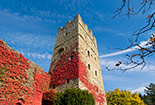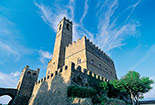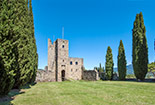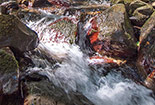DANTE‘S PLACES
in Casentino, a Tuscan valley with which you can get familiar in every detail through this site
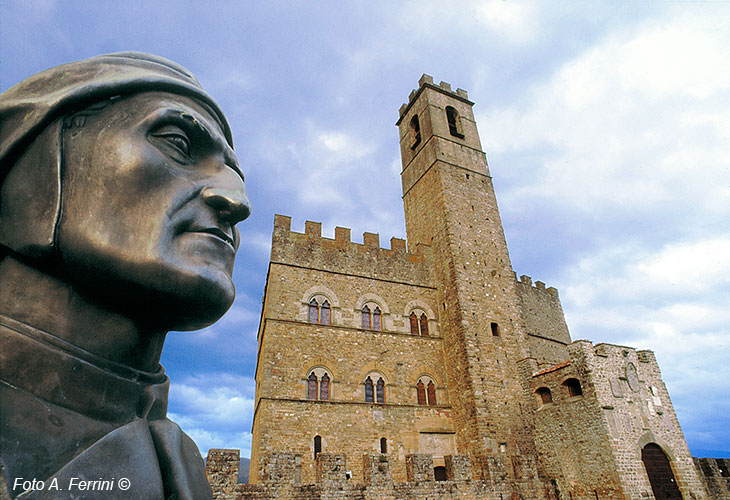
Texts and photos by Alessandro Ferrini ©
24 accurately described images about Dante,s place. Click to enlarge
Casentino, Dante's land
 Near Poppi, a few meters from a large roundabout on the road, there is a tall white marble monument with a somewhat particular shape. It is known by all as the "Column of Dante", but in reality this reference to the Supreme Poet is indirect. The monument reminds us that we are on the Campaldino plain, the scene, on 11 June 1289, of the homonymous battle between Florentines and Arezzo, or, if you like, between Guelphs and Ghibellines. Among the participants in this epic and bloody clash, which would have had so much importance on the domination of this part of Tuscany in subsequent periods, there was also the twenty-four-year-old Dante Alighieri, in the role of foster in the Florentine army, who later won. A figure that in the following centuries would have far exceeded the notoriety of all those characters, famous at the time, who took part in the battle. This is why this monument near Poppi is combined with the name of the great Florentine scholar and politician.
Near Poppi, a few meters from a large roundabout on the road, there is a tall white marble monument with a somewhat particular shape. It is known by all as the "Column of Dante", but in reality this reference to the Supreme Poet is indirect. The monument reminds us that we are on the Campaldino plain, the scene, on 11 June 1289, of the homonymous battle between Florentines and Arezzo, or, if you like, between Guelphs and Ghibellines. Among the participants in this epic and bloody clash, which would have had so much importance on the domination of this part of Tuscany in subsequent periods, there was also the twenty-four-year-old Dante Alighieri, in the role of foster in the Florentine army, who later won. A figure that in the following centuries would have far exceeded the notoriety of all those characters, famous at the time, who took part in the battle. This is why this monument near Poppi is combined with the name of the great Florentine scholar and politician.
If the Battle of Campaldino was perhaps the first, and certainly particular, encounter between Dante and the Casentino, after 1302 the "father of the Italian language" got to know this valley in depth. In fact, that year he was exiled from Florence, so the Casentino and Romagna were the lands where he stayed the most. A beautiful bust of the poet placed in front of the Castle of Poppi wants to testify to Dante's close relationship with this valley, but even more is there to remember that in 1310 he was a guest of the Counts Guidi precisely in this prestigious residence of theirs where he seems to have composed the 33th song of Hell. A "brand new" castle, in fact, was completed in those years.
Even without precise historical evidence, it is certain that the poet lived in other castles in the Casentino owned by the Guidi: that of Romena, of Porciano, in a tower along the Arno in Pratovecchio. There are many places in the Casentino that Dante mentions in the Divine Comedy, and certainly does so after having known them well in his movement in the valley. You will have seen the many castles of the Guidi at that time still in vogue, the great Romanesque churches built only one hundred and fifty years earlier, the Hermitage of Camaldoli with less than three centuries of history behind it, the Sacro Sasso della Verna where only eighty years before San Francis had received the stigmata.
In the 30th song of Hell he speaks of the streams that descend the green hills of the Casentino  and flow into the Arno. Shortly after, always in the usual song, he mentions the Castle of Romena where the forger Adamo produced his florins and Fonte Branda, located just below the manor.
and flow into the Arno. Shortly after, always in the usual song, he mentions the Castle of Romena where the forger Adamo produced his florins and Fonte Branda, located just below the manor.
Moving on to the 5th song of Purgatory, perhaps the most significant for this valley, Dante, in his meeting with Bonconte da Montefeltro whose body was never found after the Battle of Campaldino, mentions this place and the Archiano stream that rises in the Apennines above the 'Eremo di Camaldoli and flows into the Arno at the foot of the Casentino (near Bibbiena). In the same song he also recalls the Pratomagno.
In the 14th song, also of Purgatory, he speaks to us of the Arno as that "river that originates in Falterona" and its course extends over Tuscany for over one hundred miles. From the source of the river and the nearby Lago degli Idoli (sacred place for the Etruscans) it is probable that Dante passed in his movements between Casentino and Romagna. In Ravenna he died in 1321 without ever having been able to return to his beloved Florence.
Turning to Paradise, in 11th song Dante describes Verna as a raw stone between the Tiber and the Arno where San Francesco received the last seal (the stigmata). In the 22th song the poet speaks of the Hermitage of Camaldoli and the monks locked in their cells.



